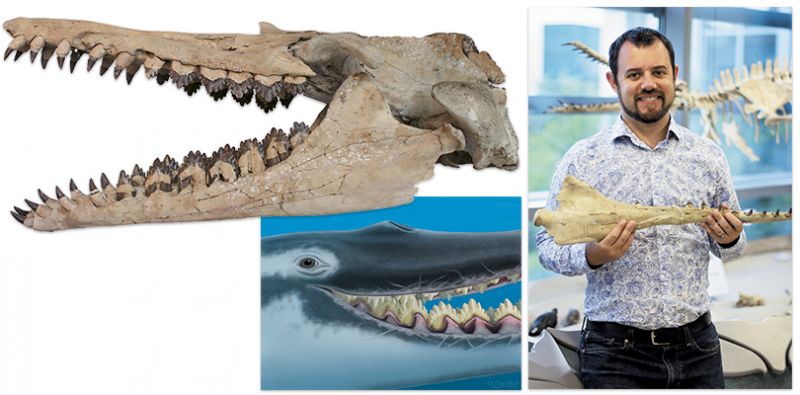Groundbreaking research at the Mace Brown Museum

Diver Mark Havenstein rescued this skull (above left) from the Wando River. Dr. Robert Boessenecker (far right) helped classify it as a new species, Coronodon havensteini, which he depicted in a life restoration (above).
Thirty million years ago, the Lowcountry we know today was under the sea, with ancestors of modern whales, dolphins, and porpoises (members of the order Cetacea) cruising through its waters.
Fast forward—way forward—to the early 1990s: diver Mark Havenstein, co-owner of Lowcountry Geologic, found and sold a peculiar cetacean fossil to collector Mace Brown. The local businessman observed strange skull indentations and sought the expertise of College of Charleston geology professor Dr. Jim Carew and New York-based cetacean expert Dr. Jonathan Geisler.
But in order for them to conduct scientific research, the fossil had to belong to a public museum. Brown decided to donate not only the cetacean (which ultimately resulted in the classification of a new species, Cotylocara macei), but the rest of his multimillion-dollar collection to CofC. In 2010, the Mace Brown Museum of Natural History opened on Calhoun Street. From a cave bear to a saber-toothed cat to myriad whales and porpoises, the ancient creatures on display are almost all native to South Carolina.
Research on this trove of extraordinarily rare treasures accelerated in 2016 when California paleontologist Dr. Robert Boessenecker arrived at CofC. Eager to build on Geisler and Carew’s work, he began studying locally found fossils that weren’t yet classified. Last summer alone, he was joined by Geisler and other scientists in reporting a previously unknown species of dolphin, Inermorostrum xenops, as well as a new genus and species of whale, Coronodon havensteini (recognize the name? It honors the diver who found the 30-million-year-old skull). Both reveal important information about how early marine mammals evolved.
To see the history-making fossils for yourself, pay a visit to the free Mace Brown Museum, open from 11 a.m. to 4 p.m. from Thursday through Tuesday. “Our cetacean exhibit is unparalleled in the world,” says Boessenecker. “No other exhibit focuses on macroevolutionary trends, showing the transition from teeth to baleen and feet to flippers, or the developments of echolocation, blowholes, and hearing.”

Boessenecker’s notebook entry for a new species of extinct dolphin
Q: What makes the Lowcounty rich in marine fossils?
A: Geology. To fossilize a dead organism, rapid burial must first occur, and it usually occurs in water. The Charleston Embayment forms between two deep-seated tectonic arches to the north and to the south. Historically (and presently), river systems bracketed between these arches funneled water and sediment from the Upstate. The sediments bury and preserve remains of organisms. Since rapid burial takes place in aquatic environments more often than terrestrial environments, more marine animals than land animals are fossilized, creating a bias in the fossil record.
Images by (2) Sarah Westmoreland & (Coronodon havensteini life restoration) Dr. Robert Boessenecker & courtesy of (skull) Dr. Robert Boessenecker